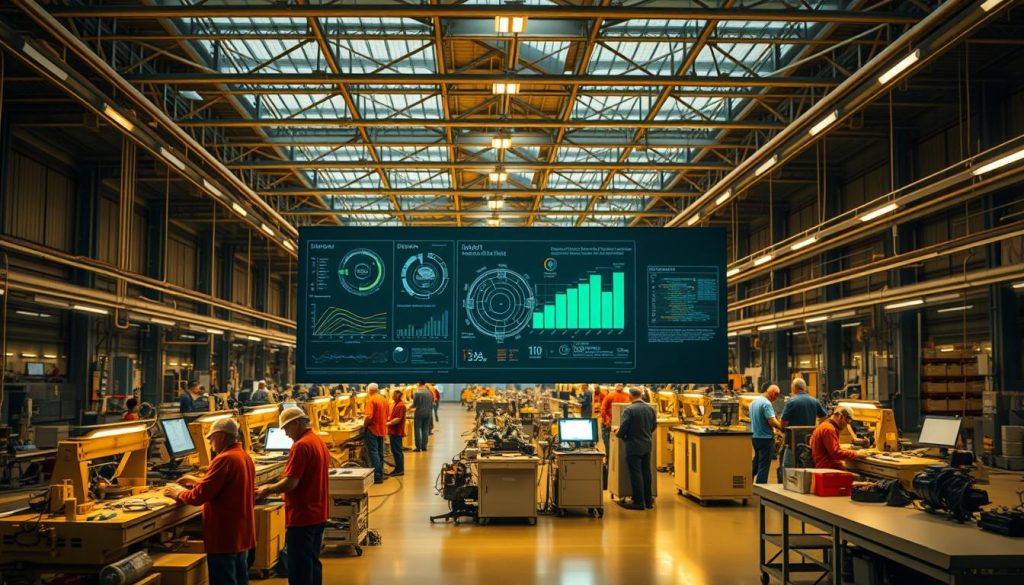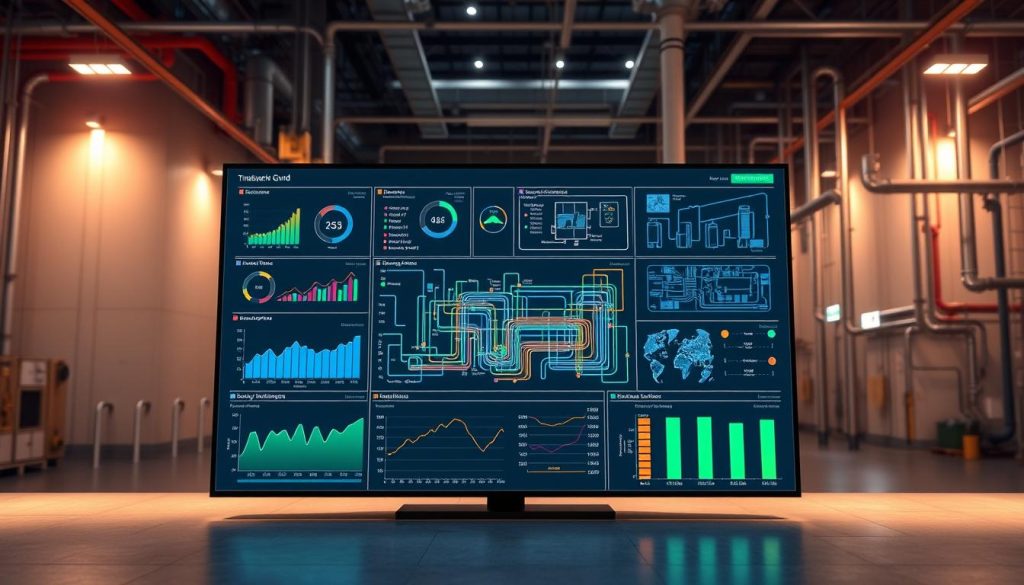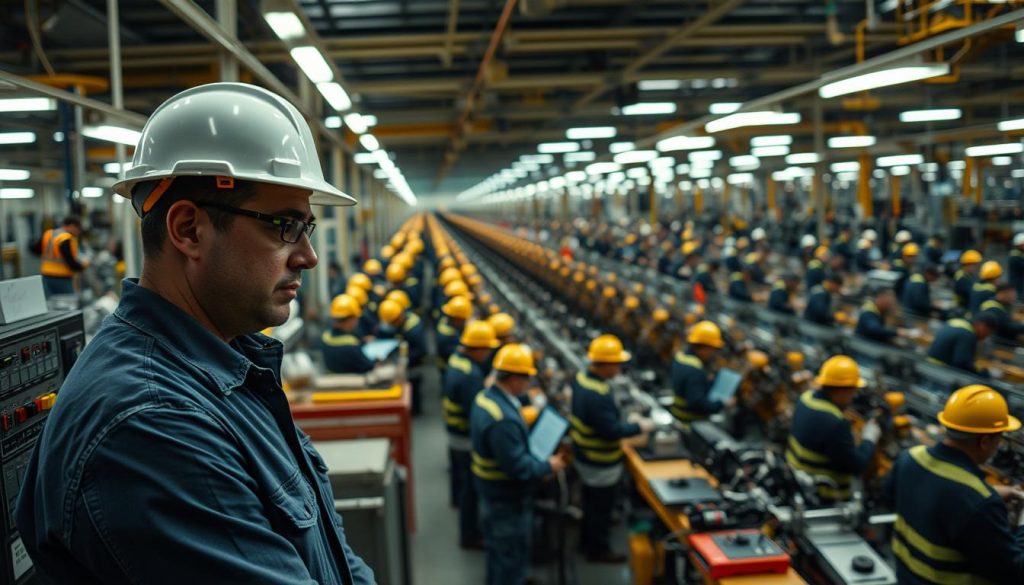The future of America’s industry relies on two key areas: using resources wisely and making workers more productive. As competition worldwide grows, U.S. makers must work smarter to produce more and spend less. They need new ways to use power and people’s skills.
In factories all over, new tech is changing how things are made. It helps cut down on waste and makes workers more efficient. This leads to better performance in supply chains, making the economy stronger during tough times.
These changes are not just about saving money. They are crucial for keeping the U.S. ahead in the global market. Companies that get better at managing resources and training workers have big advantages. They run more sustainably and offer better jobs.
The way forward is to mix technology with human know-how. This mix is key for U.S. industries to thrive in today’s tough times. The next parts will look at how businesses are using these strategies now.
The Dual Crisis Facing American Industry
The United States’ industrial scene is facing two big challenges. These are rising costs and workforce issues. These problems are linked, making it harder for businesses to stay afloat and for the economy to grow.
Rising Energy Costs and Their Impact
Energy costs have jumped a lot in the last two years. This has put a big squeeze on budgets for making things. It’s making companies think hard about how to keep making things without losing money.
This issue is tough for all businesses, but small and medium ones are hit the hardest. They’re facing tough choices:
- Absorbing higher costs and losing profit
- Increasing prices for customers and risking losing them
- Putting off upgrades to save money
- Reducing how much they make during high energy times
This problem is not just about money. It also affects how goods get made and sold, and the local economy. Without good solutions, America’s ability to make things could suffer.
Labor Shortages and Productivity Challenges
There’s also a big labor problem. Changes in who works and what they want, plus a lack of skills, have left many jobs unfilled. This is a big issue in making things.
It’s estimated that over 500,000 jobs in making things are empty. This means companies can’t make as much as they used to. They also have to pay more for overtime and make more mistakes.
There’s also a problem with skills. As older workers retire, it’s hard to find new ones who know how to do the job. This makes it hard for companies to keep making things well and to innovate.
These two big problems are connected. They need to be solved together. Companies need to find ways to use resources better and to get the right people to do the job.
Energy and Labor Efficiency: The Foundation of Economic Resilience
Energy conservation and workforce productivity are key to sustainable growth. They help American businesses save money and stay strong. By improving both, companies can better face market changes.
This link between energy and labor doesn’t just cut costs. It changes how businesses work. It helps them survive tough times and succeed in a tough global market.
Defining the Interconnection Between Energy and Workforce Productivity
Energy and labor efficiency are closely tied. For example, using energy-efficient lighting helps workers. It reduces eye strain and improves work quality.

Energy-efficient equipment also makes work better. It’s cooler and quieter, helping workers stay focused. This leads to fewer mistakes and better work.
These improvements add up. Better temperatures boost brain power by up to 10%. Automated systems also make work smoother, letting employees do more important tasks.
Historical Context and Evolution
The drive for efficiency has shaped America’s industry. In the 19th century, the focus was on machines, not energy. Factories used lots of coal without worrying about waste.
In the early 20th century, Frederick Taylor aimed to make work better. He studied how to improve labor, but energy was not a big concern.
The 1970s energy crisis changed everything. It made companies think about energy use. They started using better equipment and the government set energy standards.
Today, businesses use new tech to improve both energy and work. They use IoT, AI, and data to make things better. This shows that energy and labor are part of the same system.
The Economic Case for Efficiency
Energy and operational efficiency do more than just cut costs. They bring big benefits that change how companies work. Smart companies see efficiency as a smart investment, not just a cost. When done right, efficiency efforts can pay off three to five times their initial cost over time.
Improving efficiency is a key way to boost profits in today’s tough market. It makes companies stronger against ups and downs. It also gives them a lasting edge in the market.
Cost Savings Beyond the Electric Bill
Lowering utility bills is just the start of what efficiency can do. Companies that manage energy well see big improvements in many areas.
Keeping equipment in top shape means it lasts longer. This can add 15-30% to its life, saving money on new purchases.
Efficiency also means less downtime. Factories that use energy wisely can cut unplanned stops by 20-35%. This boosts output and earnings.
| Efficiency Benefit | Typical Financial Impact | Implementation Timeframe | ROI Range |
|---|---|---|---|
| Reduced Energy Consumption | 15-30% cost reduction | 3-12 months | 30-60% |
| Extended Equipment Lifespan | 20-40% reduced replacement costs | 12-36 months | 40-100% |
| Decreased Maintenance | 25-45% lower maintenance expenses | 6-18 months | 50-120% |
| Reduced Production Downtime | 15-35% increased production capacity | 6-24 months | 75-200% |
Competitive Advantage in Global Markets
American makers face tough competition, mainly from places with lower labor costs. But, energy and operational efficiency can level the playing field.
Companies like 3M and Dow Chemical show how being efficient can help. 3M has cut energy use by 50% since 2005. This keeps their U.S. factories competitive worldwide.
Efficiency does more than save money. It makes operations smoother and quicker to adapt to market shifts. This lets American companies grab new chances faster than others.
Also, being energy-efficient is a big plus for customers who care about the planet. Companies that show they’re efficient can get better deals and be top suppliers.
Energy Management Systems: Transforming Industrial Operations
Energy management systems are changing the game for American manufacturers. They offer a deep look into how much energy is being used. This lets companies spot and fix problems they didn’t know existed before.
These systems are a big change in how businesses manage resources. They move from just reacting to problems to actively improving things.
These solutions use hardware, software, and analytics to show how well operations are running. Companies using them often cut their energy costs by 10-30% in the first year. This is true even for small businesses, not just big ones.
Real-time Monitoring and Analytics
Being able to watch energy use as it happens is key. Real-time monitoring gives instant feedback on energy use. It shows when things are using too much power or not working right.

Real-time analytics uncover hidden patterns. For example, some processes use a lot more energy under certain conditions. Without constant monitoring, these issues stay hidden.
Smart Sensors and IoT Integration
At the heart of these systems are smart sensors. They measure things like electricity use and temperature. These sensors send data wirelessly, making it easy to set them up anywhere.
These sensors turn a factory into an “intelligent factory.” Every big energy user becomes easy to see and manage. A typical factory might have hundreds of sensors working together.
Data-Driven Decision Making
The real value of these systems is in the insights they give. Advanced analytics turn sensor data into useful information. This helps in many ways, like:
- Predicting when equipment might fail, saving on repairs
- Finding the best time to replace old equipment
- Adjusting settings to use less energy
- Showing exactly how much money is saved by being efficient
This information helps managers make smart choices. They can upgrade equipment, plan maintenance, and adjust operations with confidence.
Case Studies: Companies Leading the Way
In America, companies are showing how energy management can change things. Michigan’s Cascade Engineering cut their energy use by 29% in 18 months. They fixed a big energy waste problem with simple changes.
Georgia’s White Oak Pastures saved $137,000 a year on electricity. They fixed a problem with their refrigeration units. This saved them money and made their equipment last longer.
Even small businesses are seeing big benefits. Pennsylvania’s Tröegs Brewery cut their energy costs by 17%. They also increased their production by 22%, showing that being efficient can help grow.
Process Optimization: The Heart of Operational Excellence
Process optimization is key to making American industry more efficient. It helps companies save energy and work better. This is crucial for businesses facing today’s challenges.
It’s not just about doing more with less. It’s about cutting out things that don’t add value. Companies that get this right can save 15-30% on energy while working smarter.
Lean Manufacturing Principles for Energy Conservation
Lean manufacturing helps save energy by focusing on what’s important. It aims to improve continuously, making operations more energy-efficient.
The idea is simple: find energy uses that don’t add value and cut them out. This way, energy is managed like any other resource.
Companies start by mapping their energy use. They look for ways to improve energy-intensive areas. This often uncovers big savings, like turning off unnecessary equipment.
Waste Reduction Strategies
Reducing waste in manufacturing means cutting out energy wastes. These include overproduction and unnecessary motion. Each waste means energy is being used without adding value.
Top manufacturers use energy kaizen events to find and fix these issues. Teams work together to save energy quickly.
Value Stream Mapping for Energy Flows
Value stream mapping for energy shows where energy is used in production. It helps find hidden inefficiencies that accounting misses.
This method uses colors to show where energy is wasted. It finds ways to save 10-20% of energy with little cost.
Automation and Its Role in Resource Efficiency
Automation helps save resources by optimizing energy use. It makes adjustments based on demand and prices, something humans can’t do.
Automation doesn’t replace people; it frees them up for better work. At Harley-Davidson, it let maintenance staff focus on important tasks.
The best automation combines tech with human insight. At General Mills, automated mixing systems improved with operator input. This saved energy and made products better.
The future of optimization is in teamwork between humans and machines. This partnership is the best way to achieve excellence.
The Human Element: Empowering the American Workforce
The human element is key to sustainable industrial productivity. Advanced technologies and systems optimization help, but workers’ knowledge and skills are crucial. Companies that excel in operational excellence see their workforce as essential, not just a cost.
American manufacturers face a big challenge. They need to use new efficiency measures while filling skills gaps. Viewing workers as the main drivers of innovation is a big shift.

Training and Upskilling for the Energy-Efficient Workplace
As facilities modernize, workers need new skills. Companies are investing in training to help employees manage and optimize energy-efficient systems.
Training comes in many forms, like apprenticeships and partnerships with schools. For example, Siemens’ apprenticeship program combines classroom and hands-on learning. It prepares workers to use advanced equipment efficiently.
Effective training focuses on technical skills and critical thinking. Workers need to understand how to operate equipment efficiently and why saving energy is important. This makes them champions of operational excellence.
| Training Component | Traditional Approach | Energy-Efficient Approach | Productivity Impact |
|---|---|---|---|
| Technical Skills | Equipment operation basics | Energy-optimized operation techniques | 15-20% efficiency improvement |
| Problem Solving | Following established procedures | Identifying energy waste opportunities | Reduced downtime and resource use |
| Knowledge Transfer | Siloed expertise | Cross-functional energy awareness | Enhanced collaboration and innovation |
| Continuous Learning | Periodic formal training | Ongoing efficiency improvement culture | Sustained productivity gains |
Creating Sustainable, High-Quality Jobs
Switching to energy-efficient operations can lead to better jobs. These jobs are often more stable, safer, and pay more than traditional roles.
Energy-efficient facilities need skilled workers, like technicians and data analysts. These jobs pay well and can’t be easily outsourced.
A study by the American Council for an Energy-Efficient Economy found that energy efficiency creates more jobs than traditional energy production. These jobs cover various fields, from engineering to maintenance.
Balancing Automation with Employment Growth
Automation doesn’t always mean fewer jobs. Companies like Toyota show how it can work with human skills. Their “jidoka” concept automates tasks while focusing workers on improvement and quality.
Successful transitions plan for new roles in efficiency initiatives. When workers help plan automation, they’re happier and more effective.
Worker Well-being and Productivity Correlation
Energy-efficient workplaces are healthier and more comfortable. Better lighting, air quality, and less noise improve well-being and productivity. Green buildings have 26% higher cognition scores and 30% fewer sick-building symptoms.
Companies that focus on worker comfort and energy efficiency see big benefits. Johnson Controls found that prioritizing wellness and sustainability leads to 2.5 times more productivity gains than cost-cutting alone.
Sustainable Operations: Aligning Profit with Planet
Today, smart businesses see that being green and profitable go hand in hand. They’ve moved past the old idea that you can’t have both. Now, they see saving energy and resources as key to making more money and being kinder to the planet.
By using energy wisely, companies can cut costs and emissions at the same time. This is why more and more businesses are getting on board with green initiatives. Studies show that companies that care for the environment do better financially over time.
Reducing Carbon Footprints Through Efficiency
Improving energy efficiency is a quick way for businesses to save money and reduce carbon emissions. Unlike some green projects that cost a lot upfront, efficiency upgrades pay off fast. They’re a great first step for companies starting their green journey.
Efficiency can cut emissions by 15-30% in the first year for factories. This is done by finding and fixing waste, using better equipment, and running operations smarter.
Big names like 3M, Johnson & Johnson, and IBM have shown that setting high efficiency goals can spark new ideas. They’ve found that tracking energy use reveals ways to save even more. These savings are easy to get and make a big difference right away.
Renewable Integration in Industrial Settings
More American factories are using renewable energy, like solar and wind power. This is because the cost of these clean energies has dropped a lot. Companies with big energy needs find that using renewables helps keep costs stable and protects them from price swings in fossil fuels.
Solar panels are becoming common at factories in sunny areas. They help lower peak demand charges and provide clean energy for making things. In less sunny places, companies can support renewable projects through long-term energy deals, which also keep their costs steady.
| Renewable Integration Strategy | Primary Benefits | Implementation Complexity | Typical ROI Timeline |
|---|---|---|---|
| On-site Solar Generation | Reduced demand charges, energy independence | Moderate | 5-7 years |
| Wind Power Purchase Agreements | Price stability, large-scale impact | Low | Immediate cost savings possible |
| Microgrids with Storage | Resilience, optimization capability | High | 7-10 years |
| Biomass/Waste-to-Energy | Waste reduction, constant generation | High | 3-8 years |
Microgrids and Energy Storage Solutions
Microgrids are the next big thing in managing energy for factories. They let companies control their energy use and stay safe during power outages. Data centers, hospitals, and factories that run all the time are leading the way in using microgrids.
Energy storage, like advanced batteries, helps make renewable energy more reliable. They store extra energy when it’s made and use it when needed. This makes energy systems more flexible and reliable.
The Business Case for Green Manufacturing
Going green can give companies a big edge. They get better brand value, attract and keep employees, and avoid legal trouble. All these benefits help their stock prices.
Studies show that green products grow faster than non-green ones. Also, 73% of people want to buy things that are better for the planet. This makes it more important for companies to be green.
Now, being green is not just the right thing to do; it’s necessary for business success. Companies that listen to what customers, investors, and regulators want must be efficient and green.
Policy Frameworks Driving National Efficiency Goals
America’s path to energy and labor efficiency is being paved by new policy frameworks. These frameworks help businesses make smart, sustainable choices. They turn tough financial decisions into wise investments.
Government policies at all levels are changing how industries view efficiency. Tax breaks and rules set the stage for better operations. This makes long-term planning easier and speeds up the use of new technologies.
Federal Initiatives and Incentives
The federal government is key in pushing for more efficient industries. It offers money, research help, and rules to guide businesses. This helps them use less resources and improve their operations.
The Department of Energy’s Better Plants program works with manufacturers to set and meet goals. It provides help and recognition for their success. The Environmental Protection Agency’s ENERGY STAR for Industry program gives tools and certification for showing efficiency.

New laws have made investing in efficiency more attractive. The Inflation Reduction Act gives bigger tax credits for energy-saving upgrades. Now, businesses can get up to 30% back for efficient equipment and renewable energy.
Also, the Department of Energy has grant programs for new efficiency projects. These grants help fund projects that might be hard to finance on their own. They focus on areas with big potential for change.
Regulatory Standards and Compliance
Regulations set a minimum for efficiency, making it fair for all. They give businesses a chance to plan ahead, not just react. This helps them stay ahead of the game.
Companies that go beyond what’s required can gain an edge. They save on costs and show leadership. This also helps them avoid future risks.
State-Level Innovation and Leadership
States are like policy labs, trying new ways to improve efficiency. They tailor their efforts to fit their unique needs. This leads to innovation and better policies.
California leads in building standards, while New York aims for big cuts in emissions. Texas uses market forces to push for better efficiency. Each state’s approach is different, but they all aim to improve.
State programs often work with federal ones, offering more chances for success. They add tax breaks, rebates, and help that builds on what the feds offer.
| Policy Level | Example Programs | Financial Benefits | Implementation Timeline |
|---|---|---|---|
| Federal | Inflation Reduction Act Tax Credits | Up to 30% of project costs | Available through 2032 |
| Federal | DOE Better Plants Program | Technical assistance, recognition | Ongoing enrollment |
| State (CA) | Self-Generation Incentive Program | $0.50-$2.00/watt for storage | Annual funding cycles |
| State (NY) | NYSERDA Industrial Programs | Up to 70% of study costs, implementation incentives | Rolling applications |
| Utility | Custom Efficiency Rebates | $0.05-$0.15 per kWh saved | Varies by provider |
By using these policy layers, businesses can make efficiency investments pay off. What seems small at first can become a big win with the right incentives. This way, companies can boost their profits and help the country’s energy and economic health.
Measuring Success: Energy Audits and Performance Metrics
Effective energy audits and tracking are key to any good industrial efficiency program. Without clear ways to measure, companies can’t tell if their efforts are working. The best companies know that measuring isn’t just about paperwork. It’s about seeing clearly to make better choices and keep getting better.
Energy audits help find waste and chances for improvement. They look at how energy moves through buildings, finding spots where things aren’t working right. With ongoing tracking, they help make lasting changes in efficiency.
Key Performance Indicators for Operational Excellence
Choosing the right KPIs turns vague goals into clear targets. For energy, good indicators are energy use intensity, peak demand, and how much specific equipment uses. For labor, look at productivity per hour, how often things stop, and how fast processes finish.
The best KPIs are specific, measurable, actionable, relevant, and timely. Instead of tracking many things, pick a few key ones that match your goals. Start simple and then add more complex tracking.
Putting these indicators on dashboards with other data is key. When energy data is next to production and financial data, leaders pay attention. This makes energy management a top business priority.
| Energy KPI Category | Example Metrics | Measurement Frequency | Business Impact |
|---|---|---|---|
| Consumption | kWh per unit produced | Daily/Weekly | Direct cost reduction |
| Demand Management | Peak kW reduction | Monthly | Utility rate optimization |
| Equipment Performance | Motor efficiency ratings | Quarterly | Maintenance planning |
| Carbon Impact | CO2 emissions per $M revenue | Quarterly | ESG reporting, brand value |
Continuous Improvement Methodologies
For lasting efficiency gains, focus on ongoing improvement, not just one-time fixes. Kaizen, or continuous improvement, offers a way to find and remove waste. It encourages everyone to share ideas for small but important improvements.
The best improvement cycles include measuring, finding ways to improve, making changes, checking results, and making those changes standard. This keeps improvements from slipping back and makes them last.
Getting employees involved is crucial. When they see how their work affects energy use and productivity, they help improve things. Keeping everyone informed about goals and progress keeps everyone working towards the same goals.
Six Sigma and Energy Efficiency
Six Sigma’s focus on data and quality improvement works well for energy efficiency. Its DMAIC method (Define, Measure, Analyze, Improve, Control) helps tackle big efficiency challenges. By using stats to understand energy use, teams find the real causes of waste.
Companies using Six Sigma for energy projects often see 15-30% better efficiency. Its focus on precise measurement and stats ensures savings are real.
Benchmarking Against Industry Standards
Comparing your performance to industry standards shows how you stack up. Tools like the Department of Energy’s Better Plants Program and ENERGY STAR for Industry help. They offer benchmarks for different industries.
Good benchmarking does more than compare. It finds specific areas for improvement. If similar places use 20% less energy, you can learn from them. This competitive insight often leads to practical, proven ways to improve your operations.
Regular benchmarking also helps focus on the biggest areas for improvement. This ensures you use your resources where they’ll make the biggest difference.
Forging America’s Competitive Edge: The Efficient Path Forward
The future of American industry depends on energy and labor efficiency. Companies that optimize their processes save money and stay ahead. They cut waste in resources and work, leading to continuous improvement.
Small manufacturers can begin with simple steps to reduce waste. These efforts often uncover more savings. As efficiency grows, companies can invest in training and new tech.
Building industrial strength means working smarter, not harder. Optimizing energy use frees up money for the workforce. This leads to better jobs and attracts skilled talent, boosting innovation.
American companies focusing on efficiency today set the stage for future success. This approach is crucial for keeping our manufacturing strong and economy secure. The most competitive nations will use every resource wisely, including human potential.
The tools and knowledge to change our industrial base are available now. By making efficiency a key strategy, American manufacturers can lead in a world with limited resources. The path to success in the new industrial era is efficient, not just about survival.

